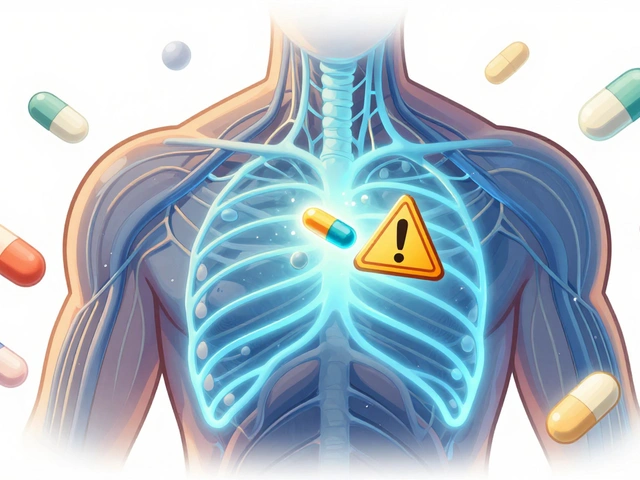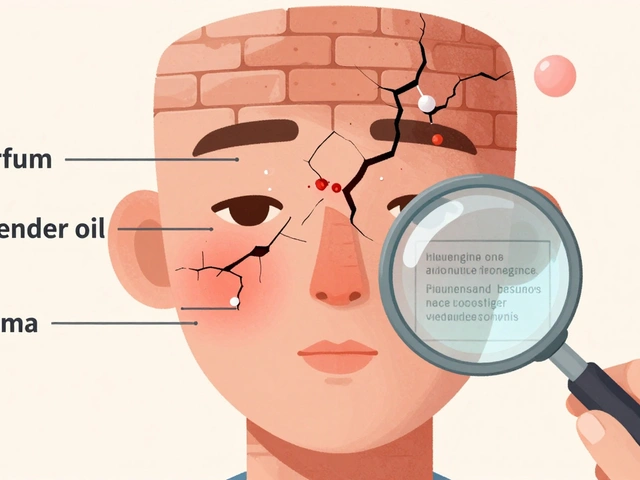
What Are Dopamine-Norepinephrine Reuptake Inhibitors, Anyway?
Most people, when they hear the term “dopamine-norepinephrine reuptake inhibitor” (or DNRI), either go blank or flash to an ad for some prescription med they can't name. But if you’ve ever taken Wellbutrin, or know someone who has, you’ve seen a DNRI in action. These drugs tweak our brain chemistry in a really specific, fascinating way. Instead of targeting serotonin, like most common antidepressants, DNRIs focus on two other big-league neurotransmitters: dopamine and norepinephrine. Both play a major role in mood, motivation, energy, appetite, and concentration.
Every neuron in your brain communicates with the next one by spilling chemicals (neurotransmitters) into the gap between cells. Normally, after the message is sent, these chemicals are sucked back up—kind of like vacuuming confetti off a dance floor after the party. DNRIs block that vacuuming process, so dopamine and norepinephrine hang around longer and keep doing their job. That little tweak can make a massive difference for someone whose low mood or focus is linked to slow reuptake.
Here’s something you might not know: dopamine isn’t just about feeling happy. It’s the driver behind “wanting” something, not just liking it. It's tied to how motivated you feel to get moving, take on a project, or even just get out of bed. Norepinephrine, meanwhile, gears you up for action and helps your brain focus. It’s kind of your natural caffeine, minus the jitters. When both are running low, depression often shows up, along with crushing fatigue, poor concentration, or that classic “brain fog.”
DNRI drugs, like Wellbutrin, turn up the action on these pathways. Folks who don't respond well to selective serotonin reuptake inhibitors (SSRIs)—which exclusively boost serotonin—sometimes find that DNRIs give them exactly what they’re missing. It's like swapping out a tool that’s just not working for one that fits better for your type of depression.
What’s especially wild is that these pathways also tie deeply into things like addiction, attention, and even pain. That’s why you’ll see DNRIs on the prescribing list not just for depression, but also sometimes for ADHD and other off-label uses.
Wellbutrin: The Standout DNRI and Its Unique Perks
Wellbutrin (generic name: bupropion) is totally different from most antidepressants you’ll hear about. For one, it doesn’t usually make you gain weight—in fact, it sometimes helps people lose a few pounds. It’s not famous for lowering libido or giving you sexual side effects, either. That’s part of why so many people ask for it by name when they’ve had a rough time with SSRIs or SNRIs.
So, what makes Wellbutrin tick? It works on both dopamine and norepinephrine, but largely steers clear of serotonin. Its structure doesn’t land in the typical mold—originally, it was even considered as a potential treatment for ADHD, and it’s actually FDA approved for smoking cessation under the brand name Zyban. So, if you hear about someone quitting cigarettes and using the same pill for depression, it’s no mistake—that’s bupropion multitasking.
The most common form is Wellbutrin XL or SR, meaning ‘extended release’ and ‘sustained release.’ These just control how the dose is delivered throughout the day. One quirky but important safety tip: never crush or chew these tablets. Doing so can make the drug hit your system way too quickly, which raises the risk of side effects, including seizures (a rare but real issue if you OD).
Here’s a known fact: Wellbutrin can make people feel more awake and alert. In some cases, you’re pretty much turbocharging your brain in the morning—you might even want to avoid taking your last dose late in the day, or you could end up counting ceiling tiles all night. For anyone feeling sluggish or sedated by other antidepressants, that activating buzz is a game-changer. It’s also a bit of a double-edged sword, though, especially for anyone with a history of anxiety—it can stoke jitters, especially early on.
From a numbers angle, about 1 in 5 people find that Wellbutrin is the key they need for their depression, especially if their energy is low rather than high-strung. Plus, it’s often used alongside other antidepressants to add back motivation or offset the sexual side effects from SSRIs. If you’ve ever been told you need a “dual-action” approach, this is what your doctor is talking about.
A real surprise to a lot of folks: while alcohol isn’t great to mix with any antidepressant, drinking on Wellbutrin can make you more prone to rare side effects like seizures. So, it’s not just a warning on the label—there’s solid science behind that caution.
Drugs with Similar DNRI Mechanisms: How Do They Compare?
While Wellbutrin (bupropion) is by far the most famous DNRI, it isn’t the only player in the game. There are a couple of other medications and even some “off-label” or experimental options that ride similar pathways, though none are quite as big in the U.S.
Let’s break them down:
- Methylphenidate (brand names like Ritalin, Concerta): This one’s actually approved mainly for ADHD and narcolepsy, not depression. But its core action? Boosts both dopamine and norepinephrine just like Wellbutrin does—though usually at a stronger, faster pace. It sits in the ‘stimulant’ category, so it comes with just as many upsides as watch-outs (think: sharp focus, but possible anxiety and sleep loss if not carefully managed).
- Dexmethylphenidate (Focalin): Like methylphenidate, used mostly for ADHD, but more targeted. These aren’t casual drugs—they’re scheduled due to the potential for misuse, but their mechanism overlaps heavily with DNRIs.
- Modafinil/Armodafinil: While not textbook DNRIs, these wakefulness agents also tweak dopamine and norepinephrine uptake as part of their multi-faceted effects. They’re often used for sleep disorders, but have off-label use in mood disorders or even cognitive enhancement.
- Newer Candidates: Sometimes, compounds that are “investigational” pop up in clinical trials. These are usually being watched for not only how they handle depression but also for their effect on motivation, attention, or addiction. But right now, nothing matches Wellbutrin’s precise DNRI status and widespread FDA approval for depression.
You might notice a theme among these: increased mental energy, alertness, and—if not handled right—potential for anxiety or insomnia. Just because a medication increases dopamine doesn't always mean it lifts mood perfectly. It’s part of why a lot of these drugs are fine-tuned differently for every person by their prescriber.
Need an alternative for Wellbutrin because of side effects or lack of insurance coverage? There are several on the market, each with its own risk-and-reward calculus. It’s never about “one size fits all.” For those who want to compare direct alternatives or even off-label options, that review gives you a snapshot of what’s out there and how these drugs stack up.

Common Side Effects, Precautions, and How DNRI Drugs Are Prescribed
Ask around, and almost no one enjoys talking about side effects, but with DNRIs like Wellbutrin, it’s a must. The upside is that, compared to SSRIs, DNRIs look friendlier when it comes to weight and sexual function. The flip side? A handful of people will get headaches, dry mouth, elevated heart rate, sweats, or feel anxious—sometimes just in the first few weeks.
Dosing is another unique angle here. Wellbutrin typically starts at a lower dose and gets ramped up, not because your brain needs time to “accept it,” but to avoid rare risks of seizures. A typical starting dose might be 150mg once a day, with careful monitoring for any agitation, insomnia, or weird mood swings. If someone’s got a seizure history, an eating disorder, or is withdrawing from alcohol or sedatives, prescribers usually steer clear.
Here’s where things get interesting: Wellbutrin interacts differently with the liver enzymes that clear other medications. Sometimes it actually increases the level of drugs like certain antipsychotics, so you’ll see docs being a bit extra-cautious with medication combos. And if you’ve ever smoked and tried to quit, you might have noticed bupropion in a double role—helping both depression and nicotine cravings.
Research published in The Journal of Clinical Psychiatry found that up to 12% of patients experienced some anxiety as a side effect early on, but this usually fades after a couple weeks. For some, switching to a slower-release version smoothed out jitteriness, underscoring how much the release formula matters.
If you’re feeling lost in a forest of brand names, here’s a quick cheat sheet:
| Drug Name | Key Neurotransmitters Affected | Main Uses | Common Side Effects |
|---|---|---|---|
| Wellbutrin (Bupropion) | Dopamine, Norepinephrine | Depression, Smoking Cessation | Dry mouth, Insomnia, Headache, Anxiety |
| Methylphenidate | Dopamine, Norepinephrine | ADHD, Narcolepsy | Loss of appetite, Increased heart rate, Anxiety, Insomnia |
| Modafinil | Dopamine (mild), Norepinephrine | Narcolepsy, Shift Work Sleep Disorder | Headache, Nausea, Nervousness, Trouble sleeping |
Prescribers today look at everything from your sleep patterns to your overall health to pick a DNRI, sometimes mixing and matching if your response isn’t perfect. Tracking side effects over the first month gives the clearest window into whether you’re on the right dose. And here’s a tip: always take the medication at the same time each day and keep your doctor in the loop if you miss a dose or feel anything out of the ordinary.
Practical Tips for Navigating DNRI Treatment
Living with depression or ADHD is hard enough without battling confusing information about medications. If you’re considering a DNRI, or already on one, here’s the stuff you often wish someone had told you earlier:
- Morning is best. Since DNRIs are activating, take your dose early to avoid late-night restlessness.
- Hydrate. Dry mouth might sound like no big deal, but it sneaks up on you—keep water handy, and sugar-free gum helps.
- Don’t skip days. Consistency isn’t just about routine; missing doses can create mood jolts or anxiety spikes.
- Let your doctor know about every supplement or med you’re using—these drugs can interact with all kinds of substances, from basic vitamins to common painkillers.
- Patience is key. It can take up to six weeks to judge how well a DNRI is working for your mood. Some side effects, especially sleep or appetite changes, may fade as your body adjusts.
- Track your symptoms. Apps or simple journals help you spot patterns, making office visits way more productive.
- Don’t mix with alcohol. This is especially true with Wellbutrin, as it can increase risk for rare but serious side effects.
- Watch caffeine. Since you’re already firing up your system with a DNRI, too much coffee can send you bouncing off the walls—monitor your intake if you start to feel extra jittery.
- Open conversations about alternatives. If something feels off, ask about trying a different formula or medication. Remember, there’s more than one route to feeling better.
Some people are thrown by an uptick in vivid dreams—that’s surprisingly common and not usually a cause for concern. Others notice increased sweating, even at room temp; dress in layers until you know how your body reacts. If you’re using Wellbutrin to quit smoking, prepare for a double adjustment: both your mood and nicotine cravings may spiral at first, but usually get much easier to manage after the early weeks.
Practical life hack: add reminder alarms for your meds, and don’t be shy about talking to your prescriber if you're having trouble sticking to the schedule. If cost is a sticking point, lots of programs or generic versions exist; don’t be afraid to bring up savings with your pharmacist.
Fine-Tuning Your Approach: DNRI Myths, Facts, and When to Ask About Alternatives
There’s a lot of confusion online about how DNRI drugs work and what “success” looks like. Some folks expect an overnight transformation. In reality, most people report subtle but important improvements—energy goes up, focus is sharper, day-to-day life feels just a bit less heavy. For a lucky few, it’s the rainy-day-to-sunshine effect; for many, it’s more gradual.
Myth: DNRIs are ‘uppers’ and will turn everyone hyper. Fact: For people with baseline low dopamine levels, restoring balance just brings things up to normal. Unless you’re cranking past the prescribed dose, you won’t suddenly develop “superpowers”—this isn’t Limitless.
Myth: Only people with depression should care about these meds. Not true. Because DNRIs shape dopamine and norepinephrine, they show up (sometimes off-label) in ADHD and certain anxiety conditions. That said, always double check with a doc before exploring any off-script use.
This class of drug deserves real respect. For anyone considering a switch, or if a DNRI isn’t hitting the mark, there’s no law saying you have to stick it out forever. Ask your doctor about trying an alternative for Wellbutrin or even combining meds safely (which is more common than you’d expect).
There’s new research all the time. For example, recent studies have linked DNRI use to improved cognitive processing speed in adults with depression—a side benefit you won’t hear about from most pharmacy pamphlets. And while the “weight-neutral” label is often repeated, about 7% of long-term users do see modest weight loss, especially if a sluggish appetite was a part of their depression.
One quick note: never start or stop a DNRI without close guidance. Some can cause withdrawal or “rebound” symptoms if you halt abruptly. Tapering, under supervision, is always the smarter call.
If you land on the right medication, it’s like unlocking a piece of your old self—the part that smiles at little things, or finally finishes a chapter in a book without zoning out. That's the true power behind understanding and using DNRIs right.






20 Comments
Reading through the DNRI overview felt like opening a window onto a hidden side of brain chemistry. The way dopamine drives “wanting” rather than just “liking” is a subtle but powerful distinction. It explains why some people feel stuck even when they know they should be happy. The connection to motivation makes the therapeutic angle more than just mood elevation. It’s a reminder that mental health treatments often intersect with the very engines of ambition.
Great rundown! If you’re starting a DNRI, remember to set a consistent morning routine so the activating effect doesn’t keep you up at night. Keep a simple symptom journal – note energy, focus, and any jitteriness – and bring it to your next appointment. Small tweaks like staying hydrated and limiting caffeine can smooth the adjustment period.
What stands out in the article is the emphasis on titration to mitigate seizure risk. Starting at 150 mg and gradually increasing allows the neurochemical balance to settle before higher dopaminergic activity kicks in. Clinicians also monitor for emergent anxiety, especially in patients with a prior anxiety disorder. The interaction with CYP2B6 enzymes can affect plasma levels of other psychotropics, so a medication review is prudent. Overall, the piece captures the practical prescribing considerations well.
Wellbutrin’s mechanism, as described, is fascinating, especially considering its dual action on dopamine and norepinephrine, which differentiates it from typical serotonergic agents, and this duality accounts for its unique side‑effect profile, such as lower rates of sexual dysfunction and weight gain, but also the potential for insomnia and increased heart rate, which clinicians must weigh carefully when selecting a treatment plan.
Thanks for the clear breakdown! 😊 The part about dry mouth can be a real nuisance, so I always suggest a sugar‑free gum or water bottle handy. Also, keep an eye on blood pressure if you notice any palpitations – just a heads‑up for those on higher doses. And remember, taking the XL version in the morning really does help avoid those late‑night “counting ceiling tiles” moments. 🌟
Oh great, another “miracle drug” that supposedly kicks you out of the fog without any real downsides. Sure, just ignore the seizure warning and tell patients to “just stay hydrated.” Because nothing says responsible prescribing like a side‑effect that can land you in the ER if you miss a dose. And the “natural caffeine” line? Please, we all know it’s just a fancy way to sell you more pills.
Did u realize how pharma pushes DNRIs as the next big thing while they keep the real natural solutions hidden? They want us to think only pills can fix dopamine, but try reading about diet changes and exercise - those work too. Dont be fooled by the big name ads.
Wellbutrin isnt for everyone, its just one option.
Absolutely love the journal tip! 📓 It’s amazing how a few notes can reveal patterns you’d never notice otherwise. Keep it up, the progress will show! 🌈
Yea thats a good point about titration i didnt think about the seizure risk but its good to know. Thanks for the info!
Totally agree about the gum trick 😁 Also, I found that a bit of magnesium helps the dry mouth and keeps the muscles relaxed at night.
The neuropharmacological profile of bupropion, classified as a norepinephrine‑dopamine reuptake inhibitor (NDRI), warrants a nuanced appraisal beyond its antidepressant label. Its mechanism involves inhibition of the presynaptic transporters responsible for the reuptake of dopamine (DAT) and norepinephrine (NET), thereby augmenting synaptic concentrations of these catecholamines. This pharmacodynamic action engenders a cascade of downstream effects, including modulation of intracellular cAMP pathways and enhanced neurotrophic factor expression. Clinically, such augmentation translates into amelioration of anhedonic symptoms, which are often refractory to serotonergic agents. Moreover, the absence of significant serotonergic activity correlates with a reduced incidence of sexual dysfunction, a common adverse effect in selective serotonin reuptake inhibitors (SSRIs). The drug’s metabolic fate is predominantly mediated by cytochrome P450 isoenzyme CYP2B6, implicating potential pharmacokinetic interactions with agents such as efavirenz and cyclophosphamide. Dose‑dependent seizure risk, albeit low, necessitates a conservative titration schedule commencing at 150 mg daily, with incremental up‑titration contingent upon tolerability. Meanwhile, the extended‑release (XR) formulation delivers a steadier plasma concentration curve, minimizing peak‑related adverse events. Empirical evidence also links bupropion to modest weight loss, likely mediated by its appetite‑suppressing properties via hypothalamic pathways. In the realm of smoking cessation, the brand Zyban exploits the same dopaminergic reinforcement to attenuate nicotine cravings. Adverse event profiling consistently identifies insomnia, dry mouth, and heightened anxiety as the most prevalent early‑onset symptoms, often resolving with continued therapy. The therapeutic window for bupropion is further refined by its off‑label utility in attention‑deficit hyperactivity disorder (ADHD), where dopaminergic enhancement improves executive function. Nonetheless, clinicians must remain vigilant for emergent manic or hypomanic episodes in bipolar spectrum patients, given the drug’s stimulant‑like properties. Patient education should emphasize adherence to morning dosing to align with circadian rhythms and mitigate nocturnal activation. Finally, comprehensive monitoring-including baseline seizure threshold assessment, blood pressure checks, and periodic mood rating scales-optimizes risk‑benefit stratification for each individual.
Bupropion’s primary action is DAT and NET inhibition, raising synaptic dopamine and norepinephrine.
The way Wellbutrin turns the brain’s sluggish engine into a revved‑up racer is nothing short of electrifying. It injects a spark of motivation that can make a foggy mind feel crisp and clear, like sunrise after a storm. That boost in dopamine and norepinephrine doesn’t just lift mood; it sharpens focus, fuels ambition, and even trims the appetite for comfort‑zone complacency.
I appreciate the practical tips on timing and hydration. Consistency in dosing really does help smooth out the activation curve and reduces the likelihood of late‑day insomnia. Keeping a simple log of side effects can also guide dosage adjustments with the prescriber.
In many cultures, the stigma surrounding mental health can make it difficult for patients to discuss side‑effects openly. Providing culturally sensitive education about medications like bupropion helps bridge that gap and encourages adherence.
The quest for balance between dopamine-driven drive and norepinephrine‑mediated focus mirrors the human pursuit of purpose and clarity. Medications that fine‑tune these pathways are tools, not cures, reminding us that inner work remains essential.
Great summary! 👍 It’s helpful to see the pros and cons laid out clearly. 😊
Loved the detailed breakdown 🙌 It makes the science feel less intimidating and more accessible 😄
The article fails to address the neuroadaptive feedback loops inherent in chronic DNRI administration, a critical oversight.